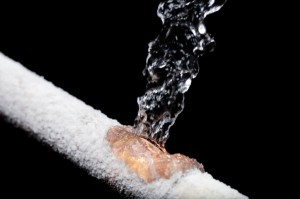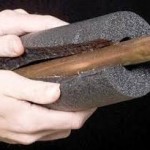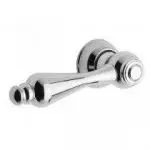 What to do about Frozen Water Pipes
What to do about Frozen Water Pipes
The damages caused by frozen water pipes can be catastrophic. Just one burst pipe in a home can cause damage in a matter of minutes, let alone the following mold mitigation problem. Contrary to belief, the pipe freezes and bursts first, then the water starts to flow once the ice thaws. For a burst to happen, the water supercools a couple of degrees lower than freezing in the pipe causing ice to form.
1 – Prevention
- Locate and identify all shut off valves in your home and make sure they work
- Everyone should know where their main water valve is and how to operate it
- Regularly exercise valve to ensure proper operation in an emergency situation.
- Identify any potential problems
- Areas where pipes may be on outside walls, ceiling, crawl spaces, attics, etc.
- Seal any gaps around the home where cold air may penetrate and become in contact with piping. In the severe cold, especially wind driven, even a tiny opening can let in enough cold air to cause a pipe to freeze.
- Dryer vents, windows, cable penetrations, etc.
- Turn off and drain all outside hose bibbs.
 2 – When the temperature is expected to drop
2 – When the temperature is expected to drop
- Open kitchen sink cabinet and vanity doors of any potential problem areas.
- With pipes that are on outside walls, leave a small trickle of both the hot and cold water running.
- Temporarily seal off any crawl space vents that may be around the foundation.
- Keep the house warm and have your furnace serviced annually.
3 – What to do if you experience a frozen pipe
The first sign of a “frozen” pipe is reduced or no flow at a plumbing fixture.
- If you experience no water at the fixture:
- Turn off the main water valve to the house and leave the faucets open
- DO NOT use any open flame to attempt to thaw the pipe
- DO NOT use an electric heater or hair dryer applied directly to the piping as any leaking water may cause electrocution
- Turning the water back on is best handled by two people. One person turning on the water slowly and the other walking around the house to be sure no water is leaking.
- Heat and patience is the best way to get the pipes to thaw. If you were lucky enough that it did not burst the first time, you may not be so lucky the next time. The pipe(s) that froze may already be fatigued so the next time they may burst.
- If water is flowing, turn off the main water valve immediately and open the lowest hot and cold faucets in your home, i.e. basement laundry tray.
- We do recommend that if a freeze occurs, have a plumber check the pipes for stress and correct the problem so the situation doesn’t repeat itself.
4 – What to do if you leave your home in the winter
- Turn the main water valve off to your home ***
- Leave the heat on to the house and set no lower than 60°
- Have a neighbor stop by daily, especially when the temperatures are in the 20s or below.
*** If you have hot water and/or steam heat, the water must remain on even when you are not there. A neighbor stopping by is critical in the scenario.
Office Hours
Monday – Friday 7:30 AM – 4:30 PM
Closed – Saturday and Sunday
Emergency Service 24/7
Certifications
WI MP #674250
IL MP #058-192451
Designer of Engineering
Systems #1949-7
Cross Connection #674250
IL Contractor #055-043916

